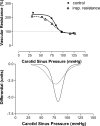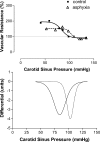Effects of simulated obstructive sleep apnoea on the human carotid baroreceptor-vascular resistance reflex
- PMID: 15073275
- PMCID: PMC1665149
- DOI: 10.1113/jphysiol.2004.062513
Effects of simulated obstructive sleep apnoea on the human carotid baroreceptor-vascular resistance reflex
Abstract
Obstructive sleep apnoea (OSA), which is characterized by periodic inspiratory obstruction, is associated with hypertension and possibly with changes in the baroreceptor reflex. In this investigation we induced changes in inspiratory resistance and in inspiratory oxygen and carbon dioxide content, which simulate some of the changes in OSA, to determine whether this caused changes in the gain or setting of the carotid baroreflex. In eight healthy subjects (aged 21-62 years) we changed the stimulus to carotid baroreceptors, using neck chambers and graded pressures of -40 to +60 mmHg, and assessed vascular resistance responses in the brachial artery from changes in blood pressure (Finapres) divided by brachial artery blood flow velocity (Doppler ultrasound). Stimulus-response curves were defined during (a) sham (no additional stimulus), (b) addition of an inspiratory resistance (inspiratory pressure -10 mmHg), (c) breathing asphyxic gas (12% O(2), 5% CO(2)), and (d) combined resistance and asphyxia. Sigmoid or polynomial functions were applied to the curves and maximum differentials (equivalent to peak gain) and the corresponding carotid pressures (equivalent to 'set point') were determined. The sham test had no effect on either gain or 'set point'. Inspiratory resistance alone had no effect on blood pressure and did not displace the curve. However, it reduced gain from -3.0 +/- 0.6 to -2.1 +/- 0.4 units (P < 0.05). Asphyxia alone did increase blood pressure (+7.0 +/- 1.1 mmHg, P < 0.0005) and displaced the curve to higher pressures by +16.8 +/- 2.1 mmHg (P < 0.0005). However, it did not affect gain. The combination of resistance and asphyxia both reduced gain and displaced the curve to higher pressures. These results suggest that inspiratory resistance and asphyxia cause changes in the baroreceptor reflex which could lead to an increase in blood pressure. These changes, if sustained, could provide a mechanism linking hypertension to obstructive sleep apnoea.
Figures






Similar articles
-
Interaction of chemoreceptor and baroreceptor reflexes by hypoxia and hypercapnia - a mechanism for promoting hypertension in obstructive sleep apnoea.J Physiol. 2005 Oct 15;568(Pt 2):677-87. doi: 10.1113/jphysiol.2005.094151. Epub 2005 Aug 18. J Physiol. 2005. PMID: 16109727 Free PMC article. Clinical Trial.
-
Carotid baroreflex regulation of vascular resistance in high-altitude Andean natives with and without chronic mountain sickness.Exp Physiol. 2006 Sep;91(5):907-13. doi: 10.1113/expphysiol.2005.033084. Epub 2006 Jun 8. Exp Physiol. 2006. PMID: 16763007
-
Prolonged latency in the baroreflex mediated vascular resistance response in subjects with postural related syncope.Clin Auton Res. 2005 Jun;15(3):207-12. doi: 10.1007/s10286-005-0273-8. Clin Auton Res. 2005. PMID: 15944870 Clinical Trial.
-
Baroreceptor resetting and other determinants of baroreflex properties in hypertension.Clin Exp Pharmacol Physiol Suppl. 1989;15:45-64. doi: 10.1111/j.1440-1681.1989.tb02995.x. Clin Exp Pharmacol Physiol Suppl. 1989. PMID: 2680189 Review.
-
Chemoreflexes--physiology and clinical implications.Acta Physiol Scand. 2003 Mar;177(3):377-84. doi: 10.1046/j.1365-201X.2003.01083.x. Acta Physiol Scand. 2003. PMID: 12609009 Review.
Cited by
-
Acute intermittent hypoxia in rat in vivo elicits a robust increase in tonic sympathetic nerve activity that is independent of respiratory drive.J Physiol. 2010 Aug 15;588(Pt 16):3075-88. doi: 10.1113/jphysiol.2010.190454. Epub 2010 Jun 21. J Physiol. 2010. PMID: 20566662 Free PMC article.
-
Advancements in the neurocirculatory reflex response to hypoxia.Am J Physiol Regul Integr Comp Physiol. 2024 Jul 1;327(1):R1-R13. doi: 10.1152/ajpregu.00237.2023. Epub 2024 May 13. Am J Physiol Regul Integr Comp Physiol. 2024. PMID: 38738293 Free PMC article. Review.
-
Associations between primary aldosteronism and diabetes, poor bone health, and sleep apnea-what do we know so far?J Hum Hypertens. 2020 Jan;34(1):5-15. doi: 10.1038/s41371-019-0294-8. Epub 2019 Dec 10. J Hum Hypertens. 2020. PMID: 31822780 Review.
-
Interaction of chemoreceptor and baroreceptor reflexes by hypoxia and hypercapnia - a mechanism for promoting hypertension in obstructive sleep apnoea.J Physiol. 2005 Oct 15;568(Pt 2):677-87. doi: 10.1113/jphysiol.2005.094151. Epub 2005 Aug 18. J Physiol. 2005. PMID: 16109727 Free PMC article. Clinical Trial.
-
Relationship between sleep disordered breathing and heart rate turbulence in non-obese subjects.Heart Vessels. 2019 Nov;34(11):1801-1810. doi: 10.1007/s00380-019-01430-0. Epub 2019 May 20. Heart Vessels. 2019. PMID: 31111194
References
-
- Bixler EO, Vgontzas AN, Lin H-M, Have TT, Leiby BE, Vela-Bueno A, Kales A. Association of hypertension and sleep-disordered breathing. Arch Intern Med. 2000;160:2289–2295. - PubMed
-
- Carlson JT, Hedner J, Elam M, Ejnell H, Sellgren J, Wallin G. Augmented resting sympathetic activity in awake patients with obstructive sleep apnea. Chest. 1993;103:1763–1768. - PubMed
-
- Carlson JT, Hedner JA, Sellegrem J, Elam M, Wallin BG. Depressed baroreflex sensitivity in patients with obstructive sleep apnea. Am J Respir Crit Care Med. 1996;154:1490–1496. - PubMed
-
- Cooper VL, Hainsworth R. Effect of head-up tilting on baroreceptor control in subjects with different tolerances to orthostatic stress. Clin Sci. 2002;103:221–226. - PubMed
Publication types
MeSH terms
Substances
LinkOut - more resources
Full Text Sources
Other Literature Sources

